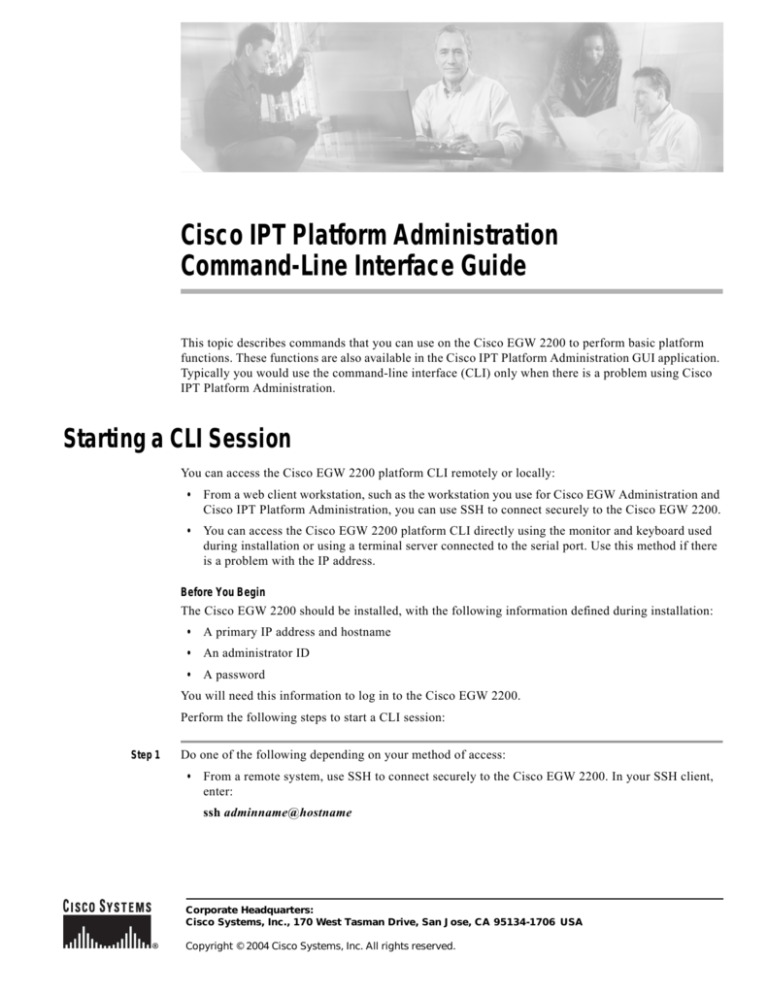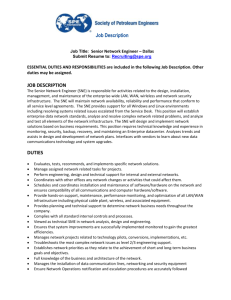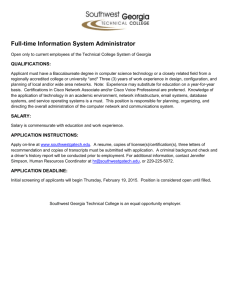
Cisco IPT Platform Administration
Command-Line Interface Guide
This topic describes commands that you can use on the Cisco EGW 2200 to perform basic platform
functions. These functions are also available in the Cisco IPT Platform Administration GUI application.
Typically you would use the command-line interface (CLI) only when there is a problem using Cisco
IPT Platform Administration.
Starting a CLI Session
You can access the Cisco EGW 2200 platform CLI remotely or locally:
•
From a web client workstation, such as the workstation you use for Cisco EGW Administration and
Cisco IPT Platform Administration, you can use SSH to connect securely to the Cisco EGW 2200.
•
You can access the Cisco EGW 2200 platform CLI directly using the monitor and keyboard used
during installation or using a terminal server connected to the serial port. Use this method if there
is a problem with the IP address.
Before You Begin
The Cisco EGW 2200 should be installed, with the following information defined during installation:
•
A primary IP address and hostname
•
An administrator ID
•
A password
You will need this information to log in to the Cisco EGW 2200.
Perform the following steps to start a CLI session:
Step 1
Do one of the following depending on your method of access:
•
From a remote system, use SSH to connect securely to the Cisco EGW 2200. In your SSH client,
enter:
ssh adminname@hostname
Corporate Headquarters:
Cisco Systems, Inc., 170 West Tasman Drive, San Jose, CA 95134-1706 USA
Copyright © 2004 Cisco Systems, Inc. All rights reserved.
CLI Basics
where adminname is the Administrator ID and hostname is the hostname defined during
installation.
For example, ssh admin@egw-1.
•
From a direct connection, you receive this prompt automatically:
egw-1 login:
where egw-1 is the host name of the system.
Enter the administrator ID defined during installation.
In either case, you are prompted for a password.
Step 2
Enter the password defined at installation.
The CLI prompt appears. The prompt is the Administrator ID, for example:
admin:
Go on to use any of the CLI commands listed in Table 1.
Related Topics
CLI Basics
Ending a CLI Session
CLI Basics
Completing Commands
Use Tab to complete commands:
•
Type the start of a command and press Tab to complete the command. For example, if you type se
and press Tab, set is completed.
•
Type a menu command and press Tab to display all the available commands or menu commands
available at this menu. For example, if you type set and press Tab you see all the set menu
commands. Menus are followed by a *.
•
If you reach a command and keep pressing Tab, the current command line repeats; no additional
expansion is available.
Getting Help on Commands
You can get two kinds of help on any command:
•
Detailed help including a definition of the command and an example of its use
•
Short query help including only command syntax
To get detailed help, at the CLI prompt enter:
Cisco IPT Platform Administration Command-Line Interface Guide
2
Ending a CLI Session
help <command> where <command> is the command name or menu command and parameter. See
Example 1.
To query only command syntax, at the CLI prompt enter:
<command> ? where <command> is the command name or menu command and parameter. See
Example 2.
Note
If you enter a ? after a menu command, such as set, it acts like the Tab key and lists the commands
available.
Example 1
Detailed Help Example:
admin: help ping
This will send one or more ping packets to a remote destination
Example:
admin:ping www.cisco.com 5
PING www.cisco.com (198.133.219.25) from 172.22.119.166 : 56(84) bytes of data.
64 bytes from 198.133.219.25: icmp_seq=1 ttl=246 time=0.837 ms
64 bytes from 198.133.219.25: icmp_seq=2 ttl=246 time=0.962 ms
64 bytes from 198.133.219.25: icmp_seq=3 ttl=246 time=1.04 ms
64 bytes from 198.133.219.25: icmp_seq=4 ttl=246 time=0.635 ms
64 bytes from 198.133.219.25: icmp_seq=5 ttl=246 time=0.666 ms
Example 2
Query Example:
ping?
Syntax:
ping dest [count]
dest
mandatory
count
optional
dotted IP or host name
count value (default is 4)
Ending a CLI Session
At the CLI prompt, enter quit.
If you are logged in remotely, you are logged off and the ssh session is dropped. If you are logged in
locally, you are logged off and the login prompt returns, for example:
egw-1 login:
Cisco EGW 2200 CLI Commands
Table 1 lists and describes the commands available on the Cisco EGW 2200 and gives their counterpart,
if any, in Cisco IPT Platform Administration.
Caution
Use care in executing commands that may slow down call processing, as noted below.
Cisco IPT Platform Administration Command-Line Interface Guide
3
Cisco EGW 2200 CLI Commands
Table 1
Cisco EGW 2200 Commands
Command
Description
Counterpart in Cisco IPT
Platform Administration
ping dest [count]
Execute a ping command to the specified destination.
Utilities > Ping
dest (mandatory): Destination, the ipV4 or domain name.
count (optional): The number of pings to execute.
set ip
Set or change various aspects of network configuration
which are originally set at installation:
•
Set DHCP on or off
•
Set a new IP address and IP mask
•
Set a new gateway address
Settings > IP Settings
Syntax:
set dhcp iface op
iface (mandatory): interface name (eth0 | eth1)
op (mandatory): operation(yes | no)
Example:
set dhcp eth0 on
set ip iface addr mask
iface (mandatory): interface name (eth0 | eth1)
addr (mandatory): IP addr to be assigned
mask (mandatory): IP mask to be assigned
Example:
set ip eth0 10.10.140.8
255.255.255.0
set gw addr
addr (mandatory): IP address to be assigned
Example:
set gw 10.107.140.1
Note
set password admin
set ip commands force a system reboot and so
should be used with caution. You receive a warning
asking for confirmation before this command
executes.
Change the password for the Administrator account (the
default and only account) set during installation.
You will beprompted to enter and confirm the new password.
Cisco IPT Platform Administration Command-Line Interface Guide
4
-
Cisco EGW 2200 CLI Commands
Table 1
Cisco EGW 2200 Commands (continued)
Command
Counterpart in Cisco IPT
Platform Administration
Description
set security orgunit orgname locality Create a new security certificate and key for Tomcat on this state country
machine. The security key is used if you have configured
browser access to Cisco EGW 2200 to use the secure https
protocol instead of http.
Note
This command is not applicable to Cisco EGW 2200
1.1(2), which does not support https.
Use the set security command if the original key is
compromised or if your certificate has expired. After you
create the new key, use show security to display it.
Enter spaces between parameters
orgunit (mandatory)—Organization unit
orgname (mandatory)—Organization name
locality (mandatory)—Location
state (mandatory)—State
country (mandatory)—Country (2 letters)
Example:
admin:set security mydept mycorp SanJose CA US
Successful in generating self signed certificate for
unitname tomcat
Successfully generated self signed certificate for
tomcat
show files install [filename]
View the install logs file list
filename (optional): Name of the file to view.
show files logs [filename]
In Cisco EGW
Administration, use the
Collect Diagnostics
command to collect
diagnostic files
View the runtime logs file list
In Cisco EGW
filename (optional): Name of the file to view. Log files are: Administration, use the
Collect Diagnostics
weblog
command to collect
diagnostic files
activelog
inactivelog
installlog
show hw
Show the hardware platform and serial number.
Show Status >
Hardware
Cisco IPT Platform Administration Command-Line Interface Guide
5
Cisco EGW 2200 CLI Commands
Table 1
Cisco EGW 2200 Commands (continued)
Command
Description
Counterpart in Cisco IPT
Platform Administration
show security
Show the Tomcat security key and certificate information.
-
The security key is used if you have configured browser
access to Cisco EGW 2200 to use the secure https protocol
instead of http.
Note
show status
This command is not applicable to Cisco EGW 2200
1.1(2), which does not support https.
Show the dynamic status of these properties:
•
Host name
•
Date
•
Time Zone
•
Primary DNS
•
Secondary DNS
•
Domain
•
Gateway
•
For Ethernet 0 and Ethernet 1:
– DHCP (yes or no)
– Status of the interface
– IP Address
– IP Mask
•
Resources:
– Memory: Total, Free, Used
– CPU (percent): Idle, System, User
– Disk Usage: Disk/activecomes from partition /,
Disk/inactivecomes from partition /partB,
Disk/logging comes from partition /common
Cisco IPT Platform Administration Command-Line Interface Guide
6
Show Status > Platform
Status
Cisco EGW 2200 CLI Commands
Table 1
Cisco EGW 2200 Commands (continued)
Counterpart in Cisco IPT
Platform Administration
Command
Description
system [parameter]
Restart, switch versions and restart, or shut down the server System Poweroff or
as specified in the parameter:
Reboot > Reboot
Current Version
system restart: Restart current version
Note
You receive a warning
asking for confirmation
before this command
executes.
system switch-ver: Switch versions and restart
system poweroff: Shut down gracefully.
System Poweroff or
Reboot > Switch
Versions and Reboot
System Poweroff or
Reboot > Poweroff
System
traceroute dest [ethX]
Execute a traceroute command, tracing the path a packet
takes to a destination. Use to debug routing problems
between hosts.
-
dest (mandatory): Destination, the (ipV4 or domain name.
ethX (optional): The source ethernet interface, eth0 or eth1.
Cisco IPT Platform Administration Command-Line Interface Guide
7
Cisco EGW 2200 CLI Commands
Cisco IPT Platform Administration Command-Line Interface Guide
8








